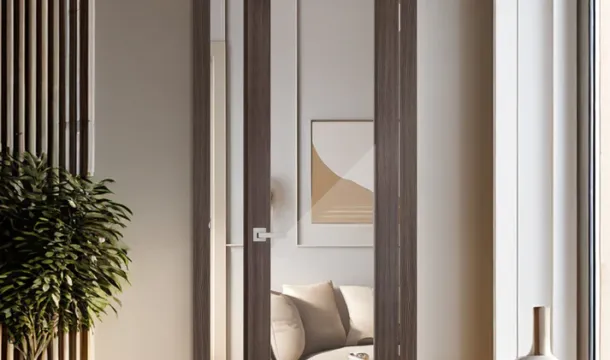Eco-Friendly Materials for Interior Doors: How to Choose Safe and Sustainable Options
Popular Articles
The materials we choose for our homes can have a significant impact on both the environment and our health. As awareness of sustainability grows, more people are seeking eco-friendly materials for interior doors to reduce their environmental footprint while creating safe and healthy living spaces. Choosing sustainable interior doors involves understanding the different types of materials available, their benefits, and how they contribute to an environmentally friendly home. This guide will help you explore various eco-friendly options for interior doors and help you make informed choices.
1. Why Choose Eco-Friendly Interior Doors?
Eco-friendly interior doors offer several benefits that go beyond aesthetics. They are made from sustainable, non-toxic materials and have a lower impact on the environment compared to conventional doors.
Benefits of Eco-Friendly Doors
-
Reduced Carbon Footprint: Choosing doors made from sustainably sourced materials or recycled content reduces the carbon footprint of your home.
-
Healthier Indoor Air Quality: Many conventional doors are made with materials that emit volatile organic compounds (VOCs), which can negatively affect indoor air quality. Eco-friendly doors are often free of harmful chemicals, creating a healthier living environment.
-
Sustainability: Materials used in eco-friendly doors are often renewable, responsibly harvested, or recycled, contributing to a more sustainable and environmentally conscious lifestyle.
2. Eco-Friendly Materials for Interior Doors
When selecting eco-friendly interior doors, it's important to consider the materials used. Here are some of the most popular sustainable materials for interior doors.
1. Bamboo
Bamboo is a highly sustainable material because it grows rapidly and requires minimal resources. It is an ideal option for those looking for an eco-friendly yet stylish choice for interior doors.
-
Sustainability: Bamboo regenerates quickly, making it one of the most renewable materials available.
-
Durability: Bamboo is strong and durable, providing a long-lasting door solution.
-
Aesthetic Appeal: Bamboo doors offer a modern and elegant look, with natural variations in color and texture that add to their charm.
2. Reclaimed Wood
Reclaimed wood is sourced from old structures, barns, or discarded wood products. By reusing existing wood, reclaimed wood doors reduce the demand for virgin timber and give a second life to materials that might otherwise be discarded.
-
Environmental Impact: Using reclaimed wood reduces waste and the need for new logging, helping preserve forests.
-
Unique Character: Reclaimed wood often has a unique character, with natural patina and imperfections that add charm and individuality to interior spaces.
-
Health Benefits: Reclaimed wood is typically free of harmful chemicals found in some newly processed woods, making it a safer choice for indoor use.
3. FSC-Certified Wood
The Forest Stewardship Council (FSC) certifies wood that is responsibly sourced from forests managed with sustainable practices. FSC-certified wood is a great choice for those looking to use new wood while ensuring that it is sustainably harvested.
-
Sustainability: FSC certification guarantees that the wood comes from responsibly managed forests that protect biodiversity and respect the rights of local communities.
-
Variety: FSC-certified wood is available in a wide variety of species, allowing you to choose a style that matches your interior design while staying eco-friendly.
4. MDF (Medium-Density Fiberboard) with Low VOCs
Medium-density fiberboard (MDF) is a popular material for interior doors because it is affordable and easy to work with. However, conventional MDF often contains formaldehyde, a harmful chemical. Opting for MDF with low or no VOCs is a more eco-friendly option.
-
Recycled Content: MDF is made from wood fibers, often using recycled materials, which helps reduce waste.
-
Low VOC Options: Look for MDF that is certified as low VOC or formaldehyde-free to reduce harmful emissions.
-
Versatility: MDF can be easily painted or veneered, allowing you to customize the look of your door.
5. Recycled Metal
For a modern and industrial look, recycled metal doors can be an eco-friendly choice. These doors are often made from reclaimed steel or aluminum, which helps reduce the environmental impact of mining and refining new metals.
-
Durability: Metal doors are highly durable and resistant to wear and tear.
-
Recyclability: Metal is 100% recyclable, which means the door can be recycled again at the end of its life, reducing waste.
-
Modern Aesthetic: Recycled metal doors provide a sleek and contemporary look that works well in modern or industrial-style interiors.
3. Choosing Non-Toxic Finishes and Adhesives
The sustainability of an interior door is not only determined by the material used but also by the finishes and adhesives. Many conventional paints, stains, and adhesives contain toxic chemicals that can harm indoor air quality.
Low-VOC Paints and Stains
-
Healthier Indoor Environment: Low-VOC (volatile organic compound) paints and stains emit fewer harmful chemicals, which improves indoor air quality and reduces health risks.
-
Wide Range of Options: Today, low-VOC finishes are available in a variety of colors and finishes, allowing you to customize the look of your door while keeping it eco-friendly.
Water-Based Adhesives
-
Eco-Friendly Choice: Water-based adhesives are free from harmful solvents and VOCs, making them a safer choice for both the environment and your health.
-
Strong Bond: Water-based adhesives are just as effective as solvent-based ones, providing a durable bond for your interior doors.
4. Tips for Choosing Eco-Friendly Interior Doors
When selecting eco-friendly interior doors, there are several factors to consider to ensure you make the best choice for your home and the environment.
1. Check for Certifications
Look for certifications such as FSC, GREENGUARD, or Cradle to Cradle, which indicate that the materials used meet stringent environmental and safety standards.
-
FSC Certification: Ensures that the wood comes from responsibly managed forests.
-
GREENGUARD Certification: Indicates that the product has low chemical emissions, contributing to healthier indoor air quality.
-
Cradle to Cradle Certification: Focuses on the entire lifecycle of the product, ensuring sustainability from production to end-of-life.
2. Choose Durable Materials
Durability is a key factor in sustainability. A durable door will last longer, reducing the need for replacement and minimizing waste.
-
Solid Wood or Bamboo: Both solid wood and bamboo are highly durable, making them ideal choices for long-lasting, sustainable interior doors.
3. Prioritize Recycled or Reclaimed Materials
Whenever possible, choose doors made from recycled or reclaimed materials. These options reduce waste and conserve natural resources.
-
Reclaimed Wood: Adds character to your home while reducing the need for new timber.
-
Recycled Metal: Offers a modern aesthetic while minimizing the environmental impact of mining and processing raw metals.
4. Consider the Manufacturing Process
The manufacturing process can significantly impact the environmental footprint of an interior door. Look for manufacturers who prioritize eco-friendly practices, such as reducing waste, conserving energy, and using non-toxic materials.
-
Local Production: Choosing doors produced locally can reduce the carbon footprint associated with transportation.
-
Energy-Efficient Manufacturing: Look for companies that use renewable energy sources or energy-efficient processes in their production.
5. Additional Eco-Friendly Features to Consider
In addition to choosing eco-friendly materials, there are other features to consider that can enhance the sustainability of your interior doors.
1. Energy Efficiency
While interior doors do not directly impact a home’s insulation like exterior doors, they can still contribute to energy efficiency, especially in heated or cooled areas of the house.
-
Solid Core Doors: These doors provide better thermal insulation compared to hollow core doors, helping maintain a comfortable indoor temperature.
2. Salvaged Hardware
Using salvaged or reclaimed hardware, such as handles, hinges, and locks, can further enhance the sustainability of your interior doors.
-
Reduced Waste: By reusing existing hardware, you can reduce waste and give new life to items that might otherwise end up in a landfill.
-
Vintage Aesthetic: Salvaged hardware can add a unique, vintage touch to your interior doors, enhancing both their appearance and sustainability.
Choosing eco-friendly materials for your interior doors is an important step toward creating a sustainable and healthy home. By opting for materials like bamboo, reclaimed wood, FSC-certified wood, and recycled metal, you can reduce your environmental impact while enjoying durable and stylish doors. Additionally, selecting non-toxic finishes and adhesives ensures that your home remains a safe and healthy space for you and your family.
With the growing availability of sustainable options, it's easier than ever to make environmentally conscious choices for your home's interior. By considering factors such as durability, certifications, and the use of recycled materials, you can choose interior doors that are both beautiful and eco-friendly, contributing to a more sustainable future.
Popular Articles

Soundproofing Interior Doors: Which Options Are Best for Your Home?

Choosing the Perfect Interior Doors for Your Canadian Home
